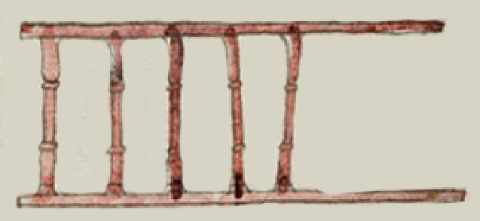cuauhchayahualli (CST26)
This painting of the simplex glyph for the term cuauhchayahualli (here, a wooden railing) shows a frontal view of a red wooden railing, with parallel horizontal boards, and five vertical, turned, spindle-like balusters. Each baluster has two beads fairly evenly spaced across its span.
Stephanie Wood
The companion text in Nahuatl explains that this railing was needed for the audiencia (either a judicial chamber or a meeting room of the Indigenous town council). For more on the Codex Sierra, see Kevin Terraciano’s study (2021), especially pp. 117–151. While this object has only one other attestation in the current state of the digital collection (October 2024), there are many other examples of wooden structures that are similar to railings and gates.
Stephanie Wood
1550–1564
Jeff Haskett-Wood
madera torneada, barandilla, fence, fences, cerca, cercado

cuauhchayahual(li), wooden railing or gate, https://nahuatl.wired-humanities.org/content/cuauhchayahualli
barandilla de madera
Stephanie Wood
Códice Sierra-Texupan, plate 26, page dated 1559. Origin: Santa Catalina Texupan, Mixteca Alta, State of Oaxaca. Kevin Terraciano has published an outstanding study of this manuscript (Codex Sierra, 2021), and in his book he refers to alphabetic and “pictorial” writing, not hieroglyphic writing. We are still counting some of the imagery from this source as hieroglyphic writing, but we are also including examples of “iconography” where the images verge on European style illustrations or scenes showing activities. We have this iconography category so that such images can be fruitfully compared with hieroglyphs. Hieroglyphic writing was evolving as a result of the influence of European illustrations, and even alphabetic writing impacted it.
https://bidilaf.buap.mx/objeto.xql?id=48281&busqueda=Texupan&action=search
The Biblioteca Digital Lafragua of the Biblioteca Histórica José María Lafragua in Puebla, Mexico, publishes this Códice Sierra-Texupan, 1550–1564 (62pp., 30.7 x 21.8 cm.), referring to it as being in the “Public Domain.” This image is published here under a Creative Commons license, asking that you cite the Biblioteca Digital Lafragua and this Visual Lexicon of Aztec Hieroglyphs.








